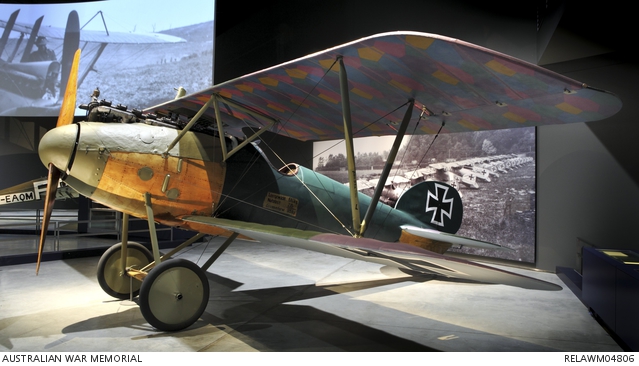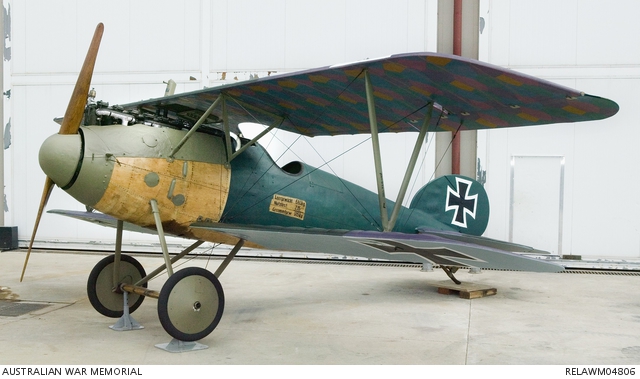| Places | |
|---|---|
| Accession Number | RELAWM04806 |
| Collection type | Technology |
| Object type | Aircraft |
| Place made | Germany |
| Date made | 1917 |
| Conflict |
First World War, 1914-1918 |
Albatros D.Va scout aircraft







Albatros D.Va single engine biplane scout/fighter aircraft, serial no. D5390/17. The fuselage is primarily constructed from moulded plywood panels, supported by a light framework of ribs and stringers. The engine is supported by two heavy timber members. At the factory, the entire fuselage was finished in clear varnish. The tail assembly consists of a fin which is integral with the fuselage, as is the centre part of the horizontal stabiliser. The latter section supports removable port and starboard stabiliser panels. Each panel is constructed from timber, with two solid spars supporting plywood ribs. The assembly is fabric covered. The rudder and the one-piece elevator are made from tubular steel and are fabric covered. The upper wing is a one-piece unit with two box spars, supporting the wing ribs. The leading edge is a solid profile strip reinforced with a plywood cap. The trailing edge is formed by a steel wire attached to the end of the ribs. The ailerons are fabricated from steel tube. The entire assembly is fabric covered. The port and starboard lower wings have a single spar but are otherwise similar in construction to the upper wing. The centre section and the outer struts are fabricated from oval section steel tube. When captured, the aircraft wings and tail were covered in a mix of plain un-dyed and printed five-colour lozenge linen fabric. In more detail, the upper wing had plain fabric on its upper surface, and five colour undersurface lozenge below. The lower left wing was covered in upper surface five colour lozenge and the lower surface equivalent on the respective surfaces. The right wing had a plain fabric covering, as did the horizontal stabiliser. The rudder was covered in five colour upper surface patten fabric. The upper wing surfaces had been overpainted in a camouflage pattern of mauve and green. The lower surfaces of the lower wings had been painted light blue. The horizontal stabiliser was finished in mauve/green camouflage paint, laid out in chord wise strips while the undersurfaces were blue. The timber areas of the fuselage had been painted green on the top and sides, and this colour extended onto both the fin and rudder. The cowlings, radiator, struts and many other external metal parts were finished in green/grey paint. The aerofoil faring on the axle remained in varnished timber. The aircraft was originally fitted with a 180 horse power Mercedes D.IIIa engine, serial no. BN 627 MN 43 MN 33842. This power plant is currently installed in the Pfalz D.XII 2600/18 (RELAWM04805). The engine currently fitted to the Albatros is BN 705 MN9 DIII Garantie BIS 12.8.18 MN 37108. The origins of this engine have not yet been established. The aircraft was received with two MG08/15 machine guns serial nos. 7778 and 7969.
In mid 1917 the Albatros D.Va entered production. Essentially an improved model of the D.III version, the new aircraft featured a redesigned fuselage and strengthening of the lower wings. Production orders were progressively increased as part of the 'Amerikaprogram' through which Germany greatly expanded its Air Service to support a planned offensive on the Western Front which would secure victory before the arrival of American troops. D.Va D5390/17 is believed to have been constructed in about August/September 1917. On the afternoon of 17 December 1917 several aircraft from 3 Squadron AFC were sent out on operational flights to take advantage of a period of fine weather. One of these machines was RE8 serial no. A3618, crewed by Lieutenant J L M Sandy (pilot) and Sergeant H F Hughes (observer). The machine climbed to its patrol height of 1,500 metres and began to range fire from an 8 in. howitzer battery, using its wireless transmitter to signal corrections to the fall of shot. The RE8 was attacked by six Albatros D.Va fighters, believed to be from Royal Prussian Jasta 29 based at Bellincamp. Sandy and Hughes successfully defended themselves for some minutes and shot down an Albatros piloted by Leutnant Rudolf Clausz. At this point another RE8 joined the action, and the two 3 Squadron machines then fought for a further 10 minutes. As a third RE8 flew to join the action, the German formation broke off combat. The third RE8 flew close to Sandy and Hughes, whose aircraft was flying normally and had apparently resumed its patrol. All appeared to be well. However, they did not return to base. Nothing was heard until the next day, when their machine was found over 80 km away. Both men had been killed by a single bullet, but their well trimmed and stable aircraft had flown unattended until fuel ran out and it landed with little damage. The entire battle was witnessed from the ground, and in their absence both Sandy and Hughes had been recommended for immediate awards (MM and DCM respectively). Leutnant Clausz, wounded in the upper thigh, crash landed in the lines of the 21st Battalion, 2nd Australian Division AIF and was taken prisoner. His aircraft, with bullet damage to the petrol tank, was recovered under heavy artillery fire by personnel of 3 Squadron AFC. After a brief examination the machine was taken to Repair Park, 1 ASD at St. Omer on 18 December 1917. It was then flown to Lympne in Kent in January 1918 and then to Aeroplane Experimental Station, RFC. It was given the identity G/101 and carefully examined. On 31 December 1917 Headquarters AIF London lodged a claim for the aircraft with the UK War Office as a war trophy. This was agreed 6 February 1918. During the early part of the year it was displayed at Australia House in London. On 22 May the aircraft was taken over by the AFC, and on the 25th the machine was dismantled and packed for shipping to Australia. After arrival D5390 was displayed in October 1920 in South Australia at an exhibition organised by the Motor Trades Association. It returned to Melbourne 30 November 1920, and was subsequently displayed by the AWM at the Melbourne and Sydney Exhibition Buildings. From 1941 the Albatros was displayed in Aircraft Hall, where it remained until the early 1960s when it was removed and stored at Duntroon. In the mid 1960s substantial reconstruction of this aircraft was undertaken. The work was commenced by the Australian Society of World War One Aviation Historians, and was completed by personnel from the Camden Museum of Aviation under the direction of Mr Harold Thomas. Large sections of the fabric have survived, and were used to guide the finish applied to the aircraft during major work completed in 2008.
Share this page
Related information
Conflicts
Events
Places
Subjects
People
Related Objects
- A view of portion of the exhibits at the Australian War Museum, in Australia House. In the ...
- Pilots pair of canvas & woollen fleece flying overboots : Leutnant Clausz, Jasta 29, German Air Service
- Albatros D.Va Scout Aircraft : Throttle
- Portrait of Lieutenant (Lt) James Lionel Montague Sandy. A company secretary from Burwood, NSW ...
- [Death of Sandy and Hughes]
- Mounted gravemarker : Lieutenant J L Sandy, 3 Squadron, Australian Flying Corps
- Framed newspaper cuttings: Lieutenant J L Sandy, 3 Squadron, Australian Flying Corps
- Commemorative scroll: Lieutenant J L Sandy, 3 Squadron, Australian Flying Corps
- Pair of business stickers: James Sandy & Co. Ltd.